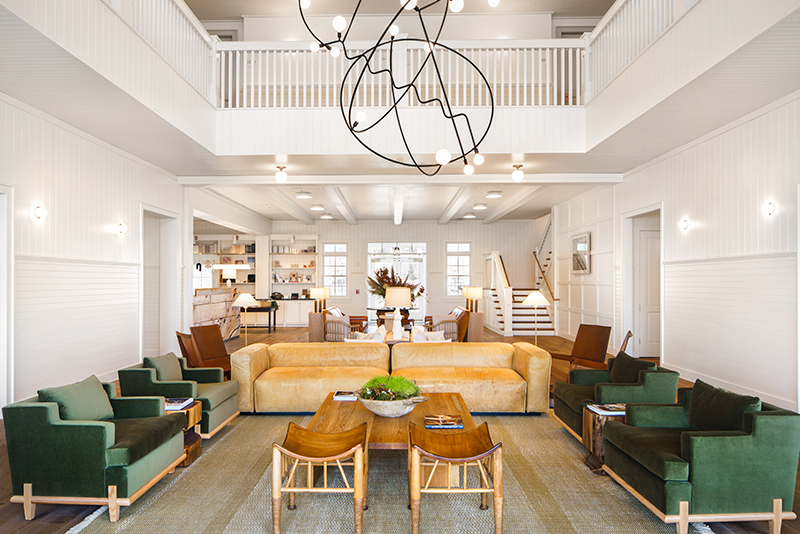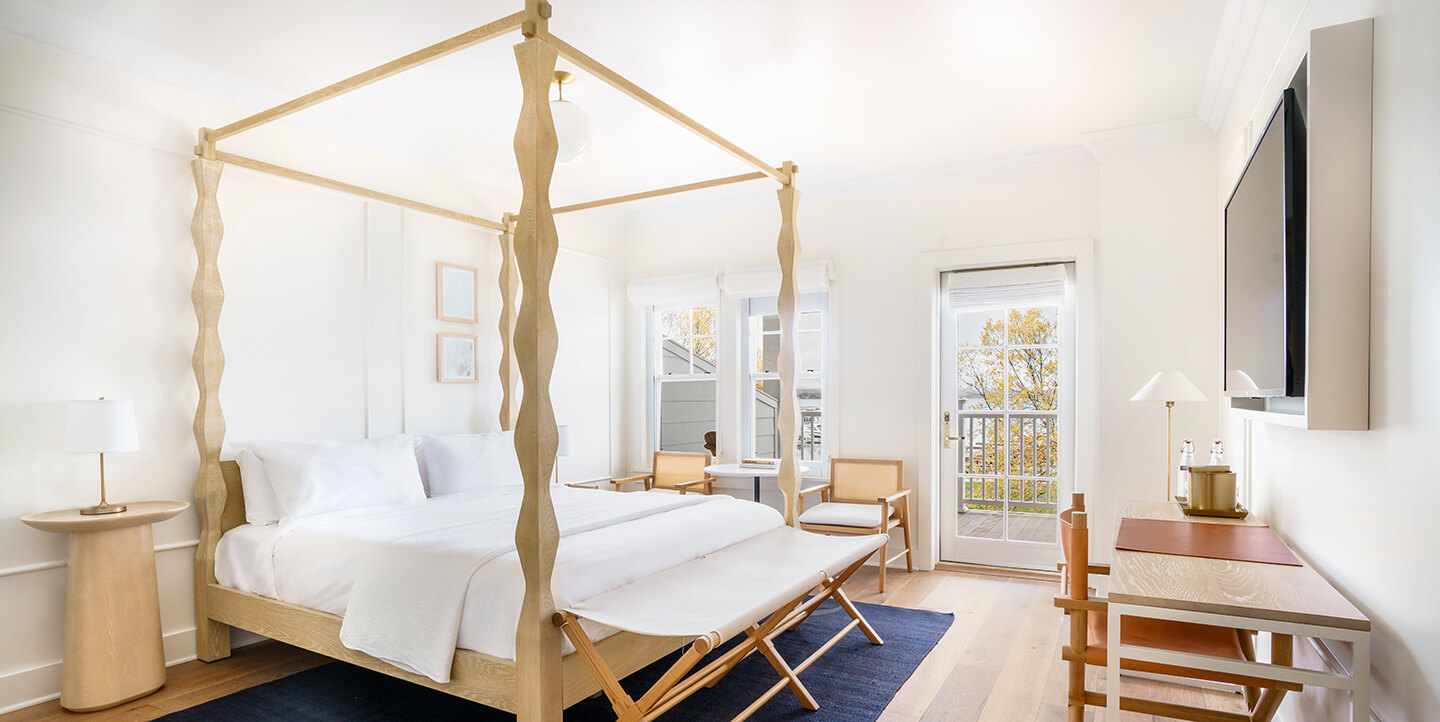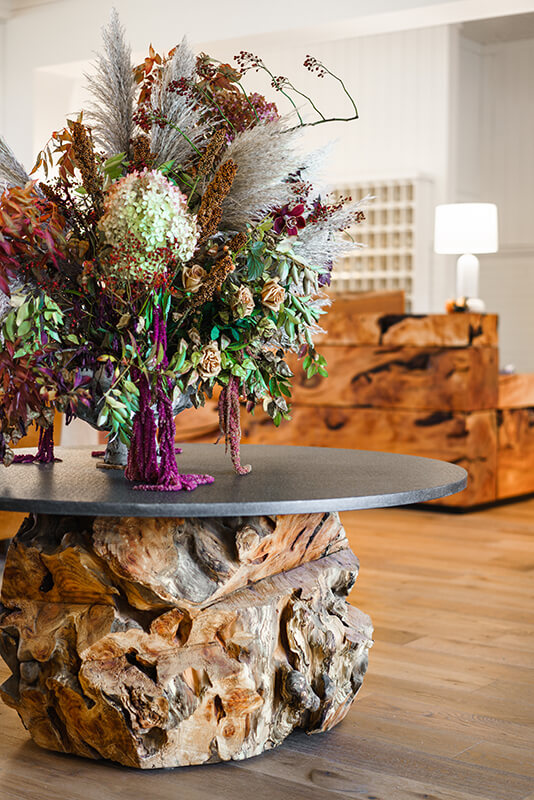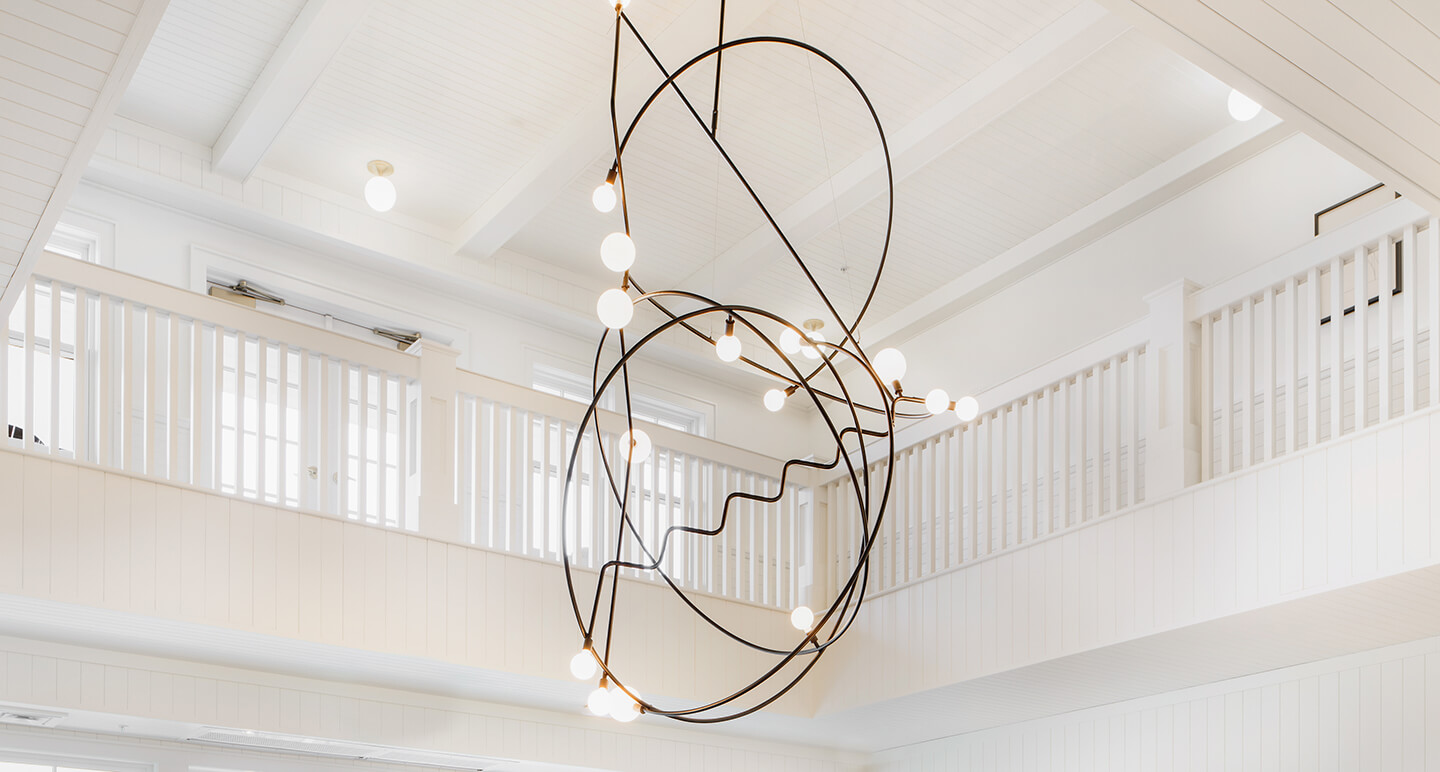How Sculptor Fitzhugh Karol Approached Art at The Lake House
Art around every corner.Brooklyn artist Fitzhugh Karol’s work has a monumental feel, even on a smaller scale, but textured materials like reclaimed woods or weathered metals lend a sense of warmth and texture to each piece. As an integral member of the Lake House design team and a part of the Sands family, Fitzhugh introduced sculptural elements inside the property in the form of custom furniture, and installed some abstract forms on the property as well. We caught up with him to chat about the process of choosing the right pieces for The Lake House—and how everything comes back to the land.
Q. How did you approach designing pieces that felt unique and at home inside the rooms?
Well my wife, Lyndsay Caleo, really led the creative direction, along with Studio Tack. My involvement design-wise was creating these specific items that made a really big visual impact. The carved beds in the rooms were a big piece of that. They’re based on a four-poster bed I had carved from a beech tree for my own house, a kind of Brancusi-like endless column shape. For the hotel we played with them being a little more asymmetrical, and made shorter posts so they wouldn’t dominate the space. The suites also have carved fireplace mantels that have a carved mantelpiece for some added warmth.

Q. What about in the common spaces?
You reach the property through a tree-lined approach, and when you first enter the lobby, you’re greeted with a carved willow trunk with a beautiful slab of wood on top, and our reception desk made from a stack of huge dried willow trees. The process of making that was really interesting, it was only possible because we found a business that could dry these massive pieces. They use a microwave kiln that actually dries the wood from the inside out—so it was really fun to kind of stretch the limits of what was possible. And then this large table has these stair-like legs on the bottom, we’re going to stack books on it and it will become this very interactive piece for everyone coming through the hotel.

The other big sculptural element is the chandelier in the lobby, which is meant to dominate the space a little bit because it’s made up of these huge linear shapes and individual lines interacting with each other. There’s a combination of step shapes with circle and saddle shapes, joining arcs that reappear in a lot of my work. So that’s one of my personal favorites.

Q. You’ve mentioned a bit how these elemental wood pieces speak to land itself. How did this location inform your creative choices?
This was always a really personal design, because it’s where Lyndsay and her brother Bill, who created this new version of this place, are from. So there was a sense of a deep connection with the lake and the immediate area right around the lake that added this really emotional element. This was an opportunity to make something in a place that has deep roots. And being on the lake really anchored us. I think something like 60% of the rooms have water views now, so it was about combining the kind of traditional wood elements. There’s so many big old barns in the region that were on everyone’s minds, especially in the event spaces, but everything is also in conversation with the water, and framing these views. I think just generally, we’re all so excited to share the beauty of this region with new people from downstate or from other places entirely, and to support the local community and other small businesses.
Q. Everything at The Lake House is site-specific, but is still in conversation with your previous work. How did that play out here?
In a bigger picture way, all my work is rooted in my experience with landscape. I’m from New Hampshire, and I always used to draw profiles of landscapes as a kid. I always loved hiking in the White Mountains, where you could come to a part where the stone had been cut in so you could climb up, this stair shape. I also discovered that in the Japanese landscape, steps imprinted right into hills. So when I got to grad school I started coming back to that silhouette of a sawtooth. Now I think it’s evolved into a bit of a broader range of shapes, and using circles and concentric circles, so you have different alignments and viewpoints when framing the landscape. Another aspect that has become important to me more recently is intractability, something that a kid will want to run up to and can be touched. I like seeing people using and living with my designs.
Q. What other art pieces should guests keep an eye out for?
There’s two big steel pieces right out front. I had these two large steel sculptures that were displayed in Brooklyn’s Prospect Park, and when it came time to remove them, I really liked how they had weathered and gotten marked up from being touched and played on—as well as the smaller shapes they made when we took them apart. So I re-worked them into these two sculptures on the lawn here, that kind of announce the personality of the place when you arrive.
Brooklyn artist Fitzhugh Karol’s work has a monumental feel, even on a smaller scale, but textured materials like reclaimed woods or weathered metals lend a sense of warmth and texture to each piece. As an integral member of the Lake House design team and a part of the Sands family, Fitzhugh introduced sculptural elements inside the property in the form of custom furniture, and installed some abstract forms on the property as well. We caught up with him to chat about the process of choosing the right pieces for The Lake House—and how everything comes back to the land.
Q. How did you approach designing pieces that felt unique and at home inside the rooms?
Well my wife, Lyndsay Caleo, really led the creative direction, along with Studio Tack. My involvement design-wise was creating these specific items that made a really big visual impact. The carved beds in the rooms were a big piece of that. They’re based on a four-poster bed I had carved from a beech tree for my own house, a kind of Brancusi-like endless column shape. For the hotel we played with them being a little more asymmetrical, and made shorter posts so they wouldn’t dominate the space. The suites also have carved fireplace mantels that have a carved mantelpiece for some added warmth.

Q. What about in the common spaces?
You reach the property through a tree-lined approach, and when you first enter the lobby, you’re greeted with a carved willow trunk with a beautiful slab of wood on top, and our reception desk made from a stack of huge dried willow trees. The process of making that was really interesting, it was only possible because we found a business that could dry these massive pieces. They use a microwave kiln that actually dries the wood from the inside out—so it was really fun to kind of stretch the limits of what was possible. And then this large table has these stair-like legs on the bottom, we’re going to stack books on it and it will become this very interactive piece for everyone coming through the hotel.

The other big sculptural element is the chandelier in the lobby, which is meant to dominate the space a little bit because it’s made up of these huge linear shapes and individual lines interacting with each other. There’s a combination of step shapes with circle and saddle shapes, joining arcs that reappear in a lot of my work. So that’s one of my personal favorites.

Q. You’ve mentioned a bit how these elemental wood pieces speak to land itself. How did this location inform your creative choices?
This was always a really personal design, because it’s where Lyndsay and her brother Bill, who created this new version of this place, are from. So there was a sense of a deep connection with the lake and the immediate area right around the lake that added this really emotional element. This was an opportunity to make something in a place that has deep roots. And being on the lake really anchored us. I think something like 60% of the rooms have water views now, so it was about combining the kind of traditional wood elements. There’s so many big old barns in the region that were on everyone’s minds, especially in the event spaces, but everything is also in conversation with the water, and framing these views. I think just generally, we’re all so excited to share the beauty of this region with new people from downstate or from other places entirely, and to support the local community and other small businesses.
Q. Everything at The Lake House is site-specific, but is still in conversation with your previous work. How did that play out here?
In a bigger picture way, all my work is rooted in my experience with landscape. I’m from New Hampshire, and I always used to draw profiles of landscapes as a kid. I always loved hiking in the White Mountains, where you could come to a part where the stone had been cut in so you could climb up, this stair shape. I also discovered that in the Japanese landscape, steps imprinted right into hills. So when I got to grad school I started coming back to that silhouette of a sawtooth. Now I think it’s evolved into a bit of a broader range of shapes, and using circles and concentric circles, so you have different alignments and viewpoints when framing the landscape. Another aspect that has become important to me more recently is intractability, something that a kid will want to run up to and can be touched. I like seeing people using and living with my designs.
Q. What other art pieces should guests keep an eye out for?
There’s two big steel pieces right out front. I had these two large steel sculptures that were displayed in Brooklyn’s Prospect Park, and when it came time to remove them, I really liked how they had weathered and gotten marked up from being touched and played on—as well as the smaller shapes they made when we took them apart. So I re-worked them into these two sculptures on the lawn here, that kind of announce the personality of the place when you arrive.




